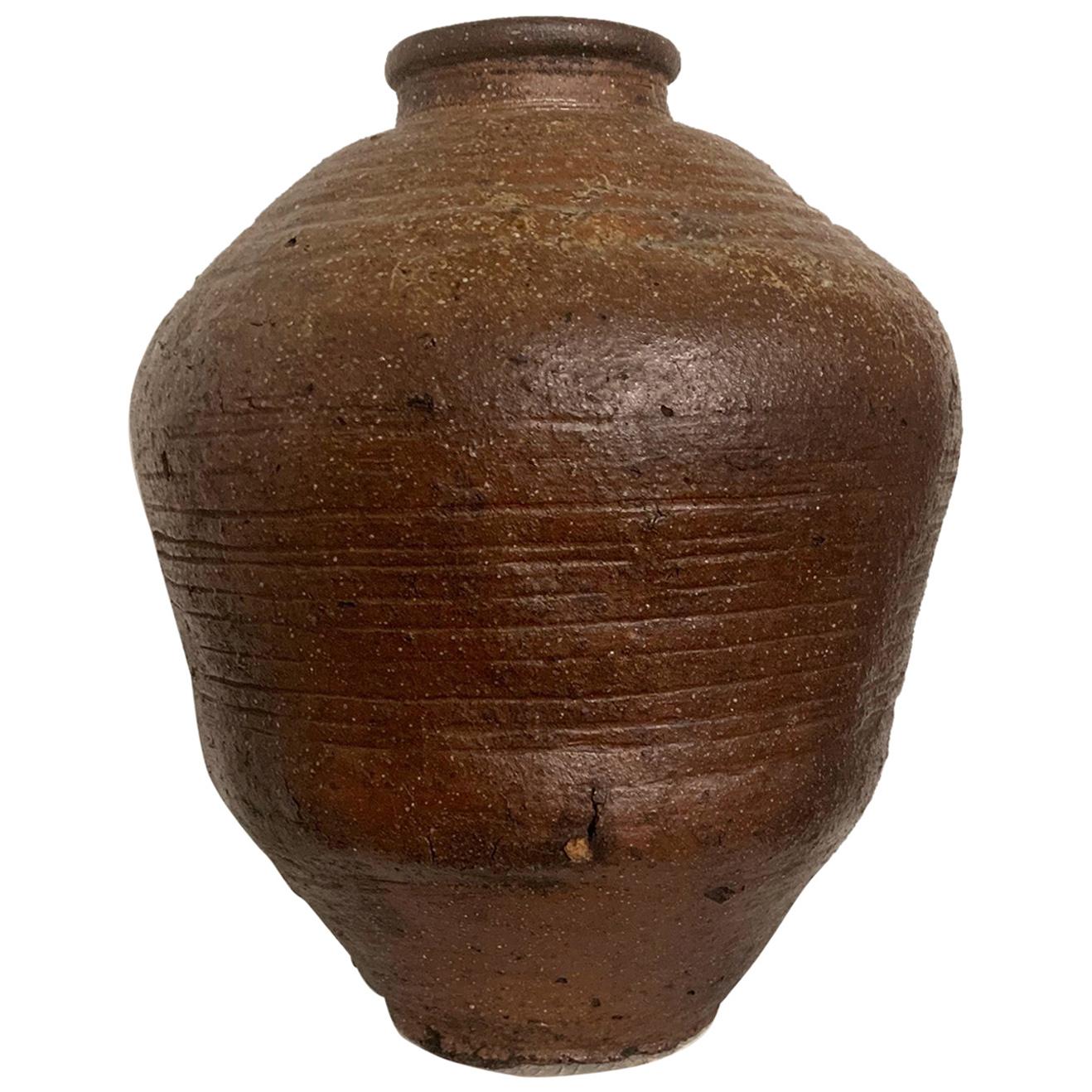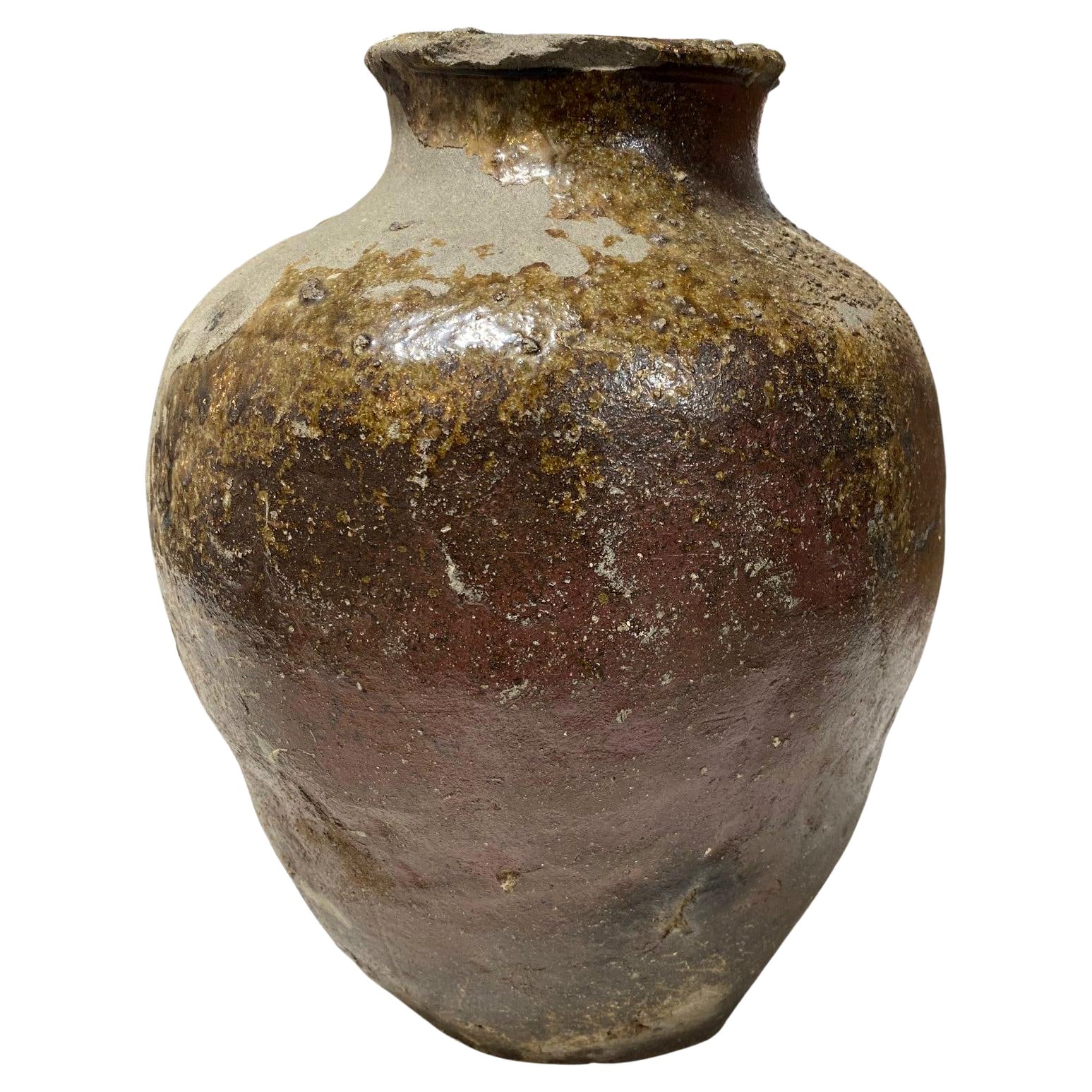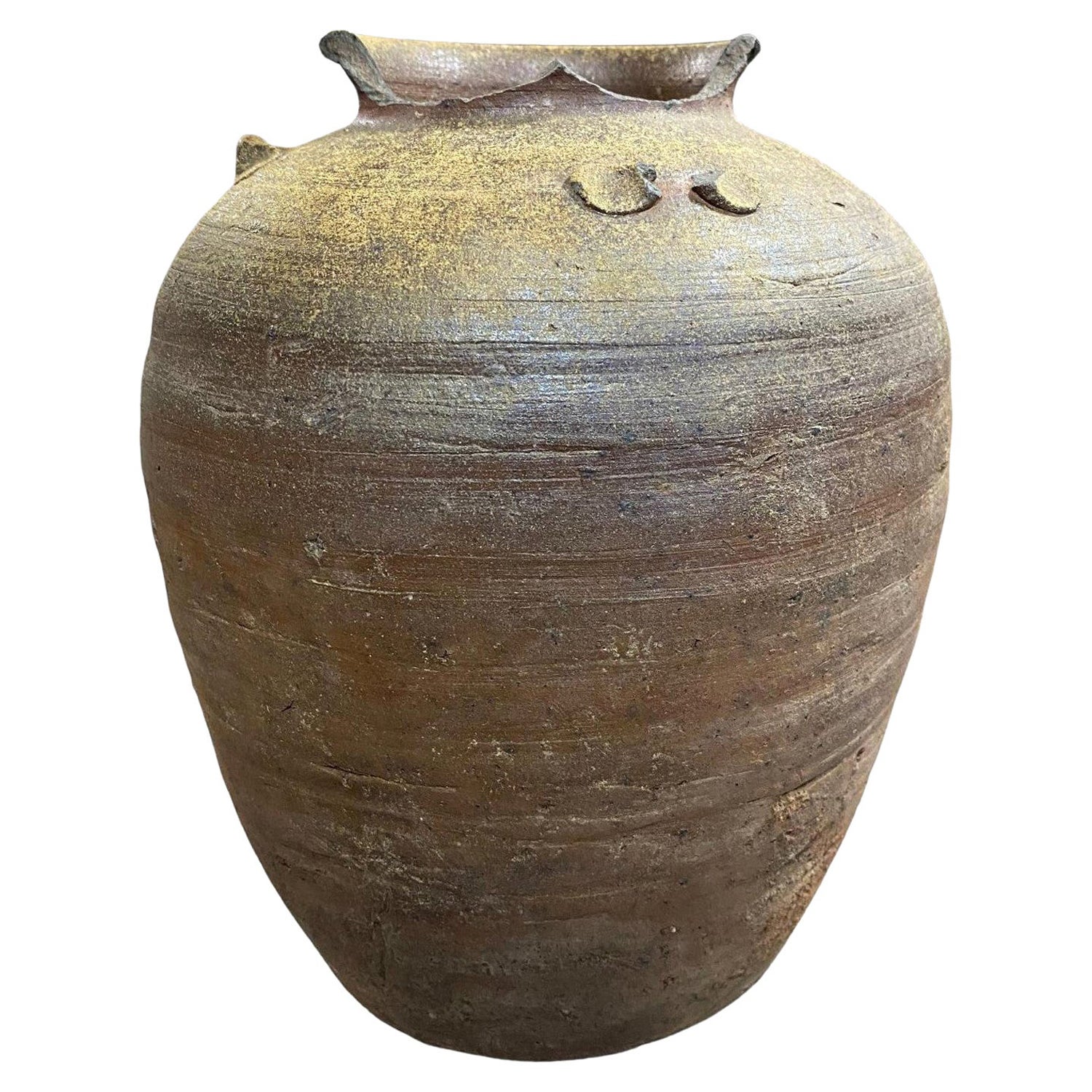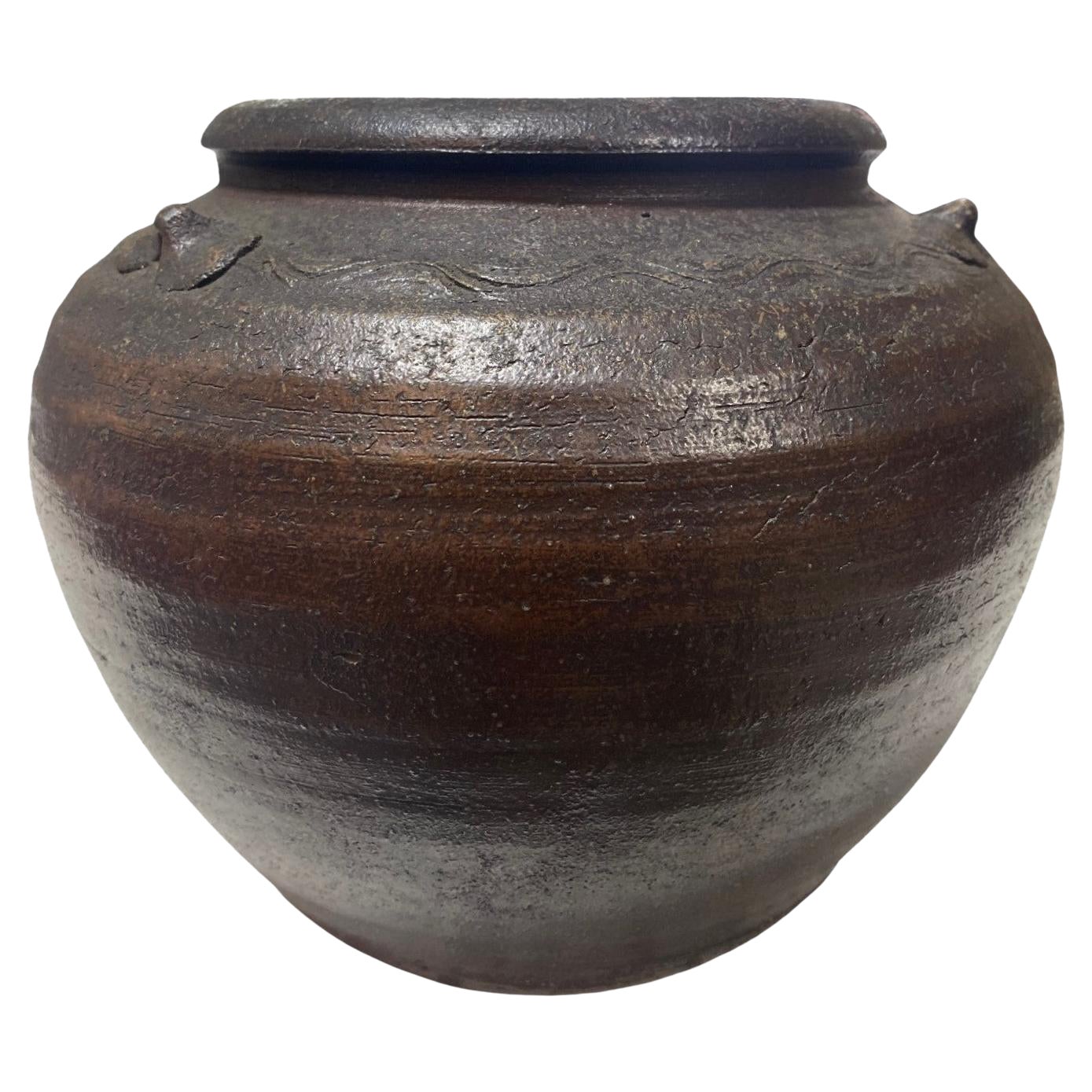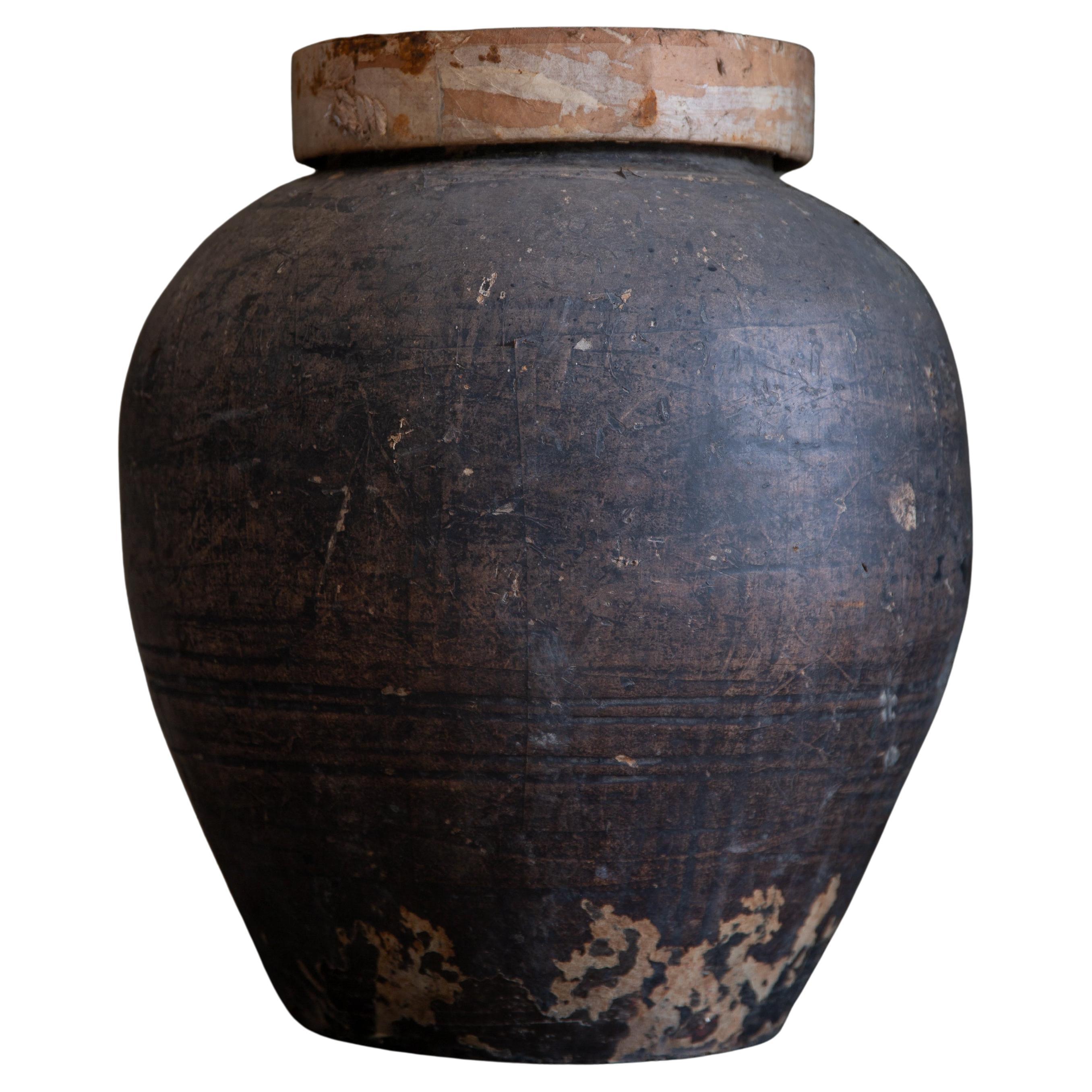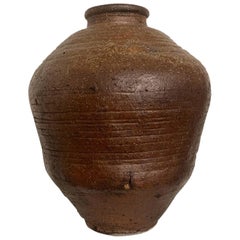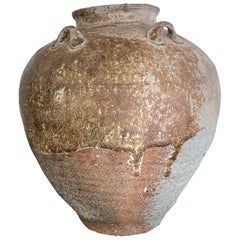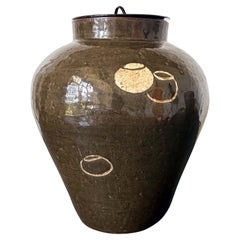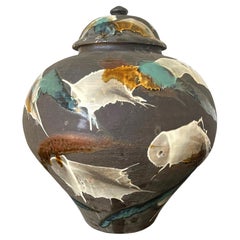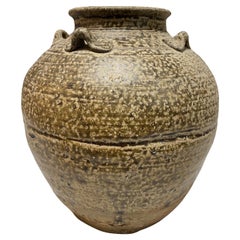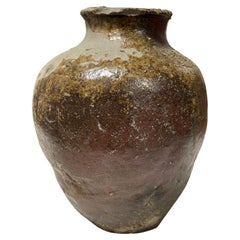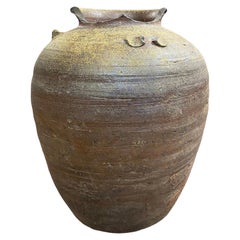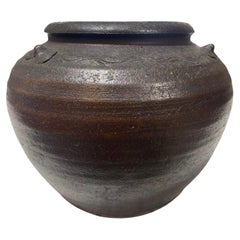Items Similar to Antique Japanese Tsubo Jar with High Relief Crab Design
Want more images or videos?
Request additional images or videos from the seller
1 of 16
Antique Japanese Tsubo Jar with High Relief Crab Design
$7,600
£5,770.86
€6,599.41
CA$10,618.30
A$11,809.87
CHF 6,166.75
MX$143,713.55
NOK 78,758.77
SEK 73,861.83
DKK 49,253.92
Shipping
Retrieving quote...The 1stDibs Promise:
Authenticity Guarantee,
Money-Back Guarantee,
24-Hour Cancellation
About the Item
A Japanese stoneware tsubo (storage jar) circa 19th century (Meiji period), likely made in one of the Shigaraki or Echizen kilns. The jar has a thick robust body, and a short-neck rimmed mouth with deep groove. It was hand-coil built from a coarse clay, fired to an iron-rich deep earthy color. The surface is partially covered with a thick ash glaze that is splashed and pooled on one side of the upper part of the body and drips down in streaks/ The lower body and the base shows unglazed reddish clay. A highly unusual feature of this jar is that on its shoulder, quite unexpectedly, there is a high-relief sculpture of a sand crab, beautifully rendered in a realistic fashion. With the meticulous molding, sculpturing and glazing, the little creature appears visually embedded in its surrounding that was made to resemble sandy dirt as if it was just crawling out of its hidden place. The decoration was creative and genuinely smart, giving the sense of an accidental encounter when one views the jar.
The high-relief decoration technique itself is not unusual in Japanese ceramic-making. For instance, applied high relief ornaments is the main feature found on the heavily glazed Sumida ware. However, it is rare to see such method applied in unglazed stoneware such as Shigaraki or Echizen. The realistic rendition of the sand crab indicates that the work was likely made in the second half of the 19th century during Meiji instead of Edo period. Artist Makuzu Kozan (1842-1916), for instance, in his early career, developed a stunning output of high-relief sculptural work (1876-1881) known as Takauki ware. Although this tsubo was unlikely from his studio, it shares a similar spirit in its artistic method and aspiration.
Tsubos were used as storage jar for tea leaves or various types of liquor. Although unitarian by nature, the tea masters in Edo period highly appreciated their earthy wabi-sabi spirit thus elevated them to cherished collectibles.
- Dimensions:Height: 14 in (35.56 cm)Diameter: 10.5 in (26.67 cm)
- Style:Meiji (Of the Period)
- Materials and Techniques:Ceramic,Glazed
- Place of Origin:
- Period:
- Date of Manufacture:19th Century
- Condition:Wear consistent with age and use. Fine antique condition.8000Natural surface with irregular ash deposits and irregularity from the firing process, as made.
- Seller Location:Atlanta, GA
- Reference Number:1stDibs: LU945037139802
About the Seller
4.9
Platinum Seller
Premium sellers with a 4.7+ rating and 24-hour response times
Established in 2006
1stDibs seller since 2010
564 sales on 1stDibs
Typical response time: <1 hour
- ShippingRetrieving quote...Shipping from: Atlanta, GA
- Return Policy
Authenticity Guarantee
In the unlikely event there’s an issue with an item’s authenticity, contact us within 1 year for a full refund. DetailsMoney-Back Guarantee
If your item is not as described, is damaged in transit, or does not arrive, contact us within 7 days for a full refund. Details24-Hour Cancellation
You have a 24-hour grace period in which to reconsider your purchase, with no questions asked.Vetted Professional Sellers
Our world-class sellers must adhere to strict standards for service and quality, maintaining the integrity of our listings.Price-Match Guarantee
If you find that a seller listed the same item for a lower price elsewhere, we’ll match it.Trusted Global Delivery
Our best-in-class carrier network provides specialized shipping options worldwide, including custom delivery.More From This Seller
View AllLarge Japanese Antique Shigaraki Tsubo Jar
Located in Atlanta, GA
An antique Japanese stoneware storage jar, known as tsubo from Shigaraki kiln, circa 17th-18th century (early Edo possibly Momoyama period)....
Category
Antique 17th Century Japanese Japonisme Ceramics
Materials
Ceramic
Antique Chinese Ceramic Tea Leaf Storage Jar Song-Yuan Dynasty
Located in Atlanta, GA
A stoneware pottery jar used for storage, made in southern China Fujian or Guangdong province since Song Dynasty for domestic use as well as export. They were widely exported to Japa...
Category
Antique 15th Century and Earlier Chinese Archaistic Ceramics
Materials
Ceramic
Japanese Ceramic Seto Tea Leaf Tsubo Jar Edo Period
Located in Atlanta, GA
A Japanese glazed ceramic jar with a lacquered wood lid circa 19th century of late Edo to early Meiji Period. The stoneware tsubo was used as a storage vessel for produce such as tea...
Category
Antique 19th Century Japanese Edo Ceramics
Materials
Ceramic
Large Japanese Contemporary Ceramic Jar from Onda Yaki Kiln
By Onda Yaki
Located in Atlanta, GA
A large Japanese lidded ceramic jar from the kiln of Onda Yaki, circa 2010. The stoneware jar impresses the viewer with a robust bulbous form. Its black body is nearly unglazed but exuberantly splashed with strokes of slip glazes of white, yellow and blue. The visual effect is wonderful that it appears traditional and contemporary at the same time. The tri-color glaze calls to mind the San-Cai from Chinese Tang dynasty, yet the application is akin to abstract painting on canvas.
Onda Yaki also spelled as Onta Yaki also spelled Onta, is a type of Japanese pottery produced in and around the village of Onta in Oita Prefecture in Kyushu Island. It was founded in 1705. Closely associated with Mingei folk art, Onda ware was inscribed by the national government in 1995 as an Intangible Cultural Property
Background from Pucker Gallery where the jar was exibited and purchased.
"In his search for true folk pottery, the Japanese philosopher Soetsu Yanagi...
Category
2010s Japanese Organic Modern Ceramics
Materials
Ceramic
Large Ceremic Shigaraki Tsubo by Nagaoka Masami
Located in Atlanta, GA
An impressive Shigaraki Tsubo (jar normally for storage) in an archaic form with a bulbous and robust body that opens with a small lipped mouth. Heavil...
Category
21st Century and Contemporary Japanese Modern Ceramics
Materials
Ceramic
Korean Ceramic Storage Jar Joseon Dynasty
Located in Atlanta, GA
A Korean ceramic storage jar circa 18th century of Joseon Dynasty. The jar is of a characteristic form with a bulbous upper body that tappers with a gra...
Category
Antique 18th Century Korean Other Ceramics
Materials
Ceramic
You May Also Like
Japanese Antique Edo Wabi-Sabi Shigaraki Tamba Tanba Art Pottery Jar Tsubo Vase
Located in Studio City, CA
A beautiful Tamba (Tanba) ware (or Sigaraki ware) Japanese pottery vase/jar/pot - produced sometime during the Edo Period (1603-1867). Tamba-yaki ware is a type of Japanese pottery a...
Category
Antique 18th Century Japanese Edo Ceramics
Materials
Pottery, Stoneware
Japanese Antique Muromachi Edo Wabi-Sabi Tokoname Art Pottery Jar Tsubo Pot Vase
Located in Studio City, CA
An absolutely stunning Tokoname ware stoneware vase/jar/vessel - produced sometime during the late Muromachi period (1336-1573 to early Edo Period (1603-1867). Tokoname-yaki ware is ...
Category
Antique 16th Century Japanese Edo Ceramics
Materials
Pottery, Stoneware
Japanese Antique Momoyama Edo Bizen Ware Pottery Wabi-Sabi Art Tsubo Jar Vase
Located in Studio City, CA
An absolutely stunning Bizen ware stoneware vase/jar/vessel - produced sometime during the late Momoyama period (1568-1600) / Early Edo Period (1603-1867). Bizen yaki...
Category
Antique 16th Century Japanese Edo Ceramics
Materials
Stoneware
Kaneshige Toyo National Treasure Signed Japanese Bizen Pottery Tsubo Jar Vase
Located in Studio City, CA
A beautiful, darkly fired, antique Bizen ware three-ear tsubo jar/pot/vase by renowned Japanese master potter/artist Kaneshige Toyo (1896-1967) featuring a l...
Category
Mid-20th Century Japanese Showa Ceramics
Materials
Stoneware
19th Japanese antique Cha Tsubo, paper covered pottery vase wabi sabi pot w/ lid
Located in 常陸大宮市, JP
From Tohoku area, Japan.
This Cha Tsubo, pottery Jar for tea leaf stoage - is a product of late Edo to Meiji era (estimate 1860s-1910) estimate from the style & condition.
The surf...
Category
Antique Late 19th Century Vases
Materials
Ceramic, Porcelain, Paper
Large Chinese Martaban Jar, Ming Dynasty
Located in Pasadena, CA
This is a large Chinese 17th Century Stoneware Martaban Jar. Martancan Jars were created to store food items such as grain, tea, oil, etc. The ...
Category
Antique Late 17th Century Chinese Chinese Export Ceramics
Materials
Terracotta
$2,380 Sale Price
20% Off
More Ways To Browse
Ceramic Relief Art
Kiln Japanese
High Relief Sculpture
Japanese Stoneware
Clay Relief
Japanese Ash
Antique Iron Glaze
Antique Storage Jars
Antique Jar Black
Antique Clay Jars
Japanese Antique Jar
Japanese Iron Sculpture
Antique Stoneware Jars
Antique Japanese Stoneware
Crab Sculpture
Wabi Sabi Jar
Ceramic Glazed Storage Jar
Antique Tea Jar
